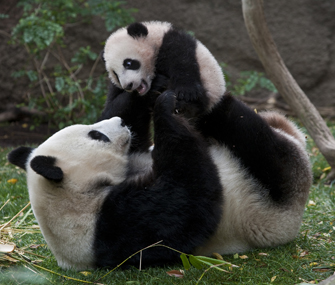How Zoos and Aquariums Help Endangered Species
Published on April 12, 2013

Zoos and aquariums are great places to get up close to wildlife from around the world, particularly species that you never would have seen otherwise. But these institutions do much more than give us a chance to ogle the animals. They are also playing a vital role in the conservation of our endangered and threatened species.
“Zoos’ roles in conservation extend well beyond our grounds,” says Dr. Lisa Faust, vice president of conservation and science at Chicago’s Lincoln Park Zoo. “Accredited zoos and aquariums in AZA [Association of Zoos and Aquariums] contributed some $160 million to conservation efforts in 130 countries, and thousands of zoo scientists are studying innumerable subjects that contribute to the greater understanding of wildlife.”
There are currently 221 accredited organizations in the Association of Zoos and Aquariums. All of these are dedicated to being leaders in conservation.
Collaborating With Others and Maintaining Populations
Many AZA-accredited organizations work with national and international institutions on research projects. According to Dr. Faust, “Some of these take place under the auspices of Species Survival Programs (SSPs), which help manage the populations in zoos but also often include conservation components."
For example, the Lincoln Park Zoo participates in the Eastern Massasauga Rattlesnake SSP, working with between 15 to 20 other zoos to monitor threatened snakes and gather data that will help manage the species in the future.
At the Mystic Aquarium in Connecticut, staff members collaborate with the South African Foundation for the Conservation of Coastal Birds to share their expertise working with and breeding endangered African penguins. The aquarium has a colony of 28 penguins and is part of a collaborative breeding program through the AZA.
“Zoos need to work together and make sure breeding is cooperative to maintain the genetic integrity of the gene pool,” says Dr. Allison Alberts, chief conservation and research officer at San Diego Zoo Global. “Species survival programs are essential to being able to do one of the things zoos do best: maintain populations of animals that shrink in the wild.”
Two successful examples of this collaboration in San Diego include their California condor and giant panda programs. There were only 22 California condors by the late 1980s, but thanks to zoos taking in the birds and successfully breeding them, there are now over 400.
As for the giant panda, the San Diego Zoo exchanged research, knowledge and people with their colleagues in China, which led to improvements in breeding programs and increases in panda habitat conservation. Now there are over 300 pandas in captivity worldwide, which Dr. Alberts says is considered a sustainable population.

The Lincoln Park Zoo has a dedicated Population Management Center responsible for managing hundreds of zoo populations by providing genetic and demographic advice. This management is important, according to Dr. Faust, because zoo populations serve “as the last insurance against complete extinction for some species that are on the brink.”
Forming a Connection With the Public
Acting as a link between the public and wildlife is another crucial way zoos and aquariums help endangered species. For many people, visiting these institutions is the only way for them to see most of these animals.
“Five million people come through our gates every year,” says Dr. Alberts. “What an opportunity to expose these people to wildlife and inspire them to help, to care more, and to make changes in their everyday life that can help wildlife in the long-term.”
Dr. Alberts says this huge audience gives zoos a major advantage over other conservation organizations. Dr. Faust agrees that zoos and aquariums must act as bridges between people and wildlife to “create a lasting bond between them and nature.”
“It has been proven that people who feel connected to animals will be more motivated to participate in conservation efforts and more likely to share that mindset with others,” says Dr. Faust.
For Erin Merz, manager of media and public relations at the Mystic Aquarium, the fact that the public can connect with such a wide variety of animals in one day proves how important these institutions are to wildlife conservation.
“You can learn from TV and books, but in person and with hands-on encounters, just touching a shark or a penguin can bring a whole new appreciation of animals,” Merz says. “These animals serve as ambassadors to those in the wild."





